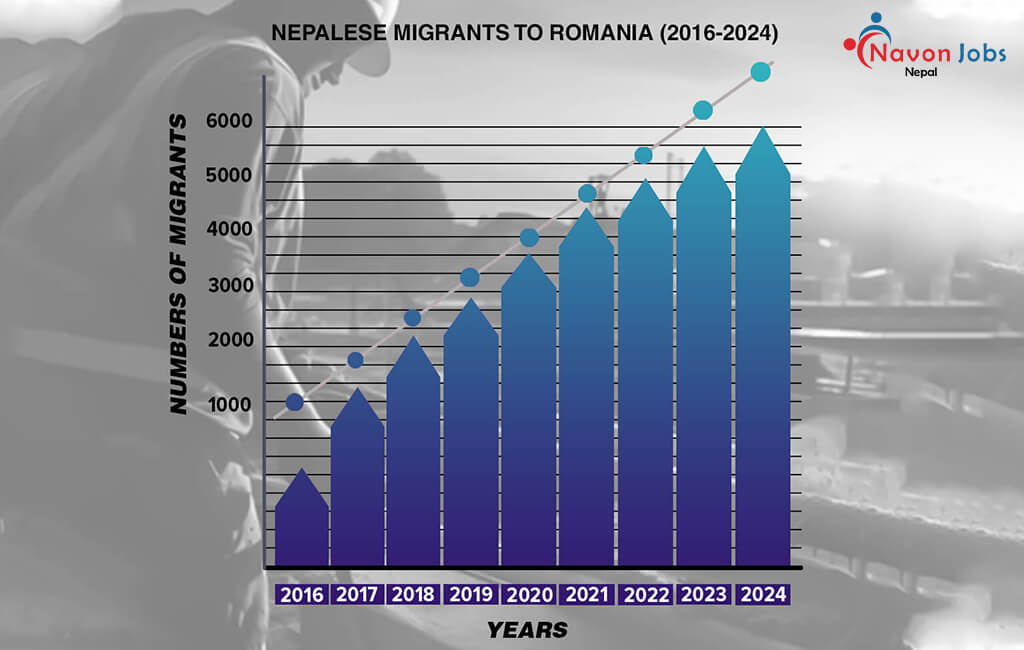How Many Nepalese Migrated to Romania from 2016 to 2024: A Yearly Breakdown
In recent years, Romania has become a popular destination for Nepalese workers seeking foreign employment, offering opportunities in construction, manufacturing, hospitality, and agriculture. With Romania set to join the Schengen Zone in March 2024, the appeal of Romania as a gateway to Europe is expected to grow even further. From 2016 to 2024, the trend of Nepalese workers migrating to Romania has steadily increased, driven by Romania's demand for labor and improved bilateral agreements between the two countries.

Why Romania?
Romania’s economic growth, particularly in sectors like construction, agriculture, and hospitality, has created significant demand for foreign workers. Nepalese workers have been in demand due to their work ethic and willingness to take up semi-skilled and skilled roles. Additionally, Romania's relatively easier visa process compared to other European countries, coupled with better pay and working conditions, made it an attractive destination.
The announcement that Romania will become a part of the Schengen Zone in March 2024 has also raised expectations for increased movement of workers and greater opportunities for labor mobility across Europe.
Year-by-Year Breakdown of Nepalese Migrants to Romania (2016–2024)
Below is a detailed breakdown of the number of Nepalese workers who traveled to Romania from 2016 to 2024.
2016: 529 Nepalese Workers
In 2016, Romania was still a relatively new destination for Nepalese migrant workers. Only 529 Nepalese workers traveled to Romania, largely for roles in the construction and manufacturing sectors.
2017: 2,215 Nepalese Workers
In 2017, the numbers rose significantly, with 2,215 workers from Nepal migrating to Romania. The demand for laborers in the construction industry played a key role in this surge, as Romania ramped up its infrastructure projects.
2018: 3,225 Nepalese Workers
By 2018, the upward trend continued, with 3,225 Nepalese workers securing jobs in Romania. Improved bilateral agreements and recruitment efforts in Nepal contributed to this steady growth.
2019: 4,812 Nepalese Workers
In 2019, the number of Nepalese workers heading to Romania jumped to 4,812, as Romanian employers increasingly sought Nepalese labor to meet growing demand in construction and hospitality sectors.
2020: 3,011 Nepalese Workers
The global COVID-19 pandemic in 2020 caused a temporary dip in the migration of Nepalese workers to Romania, with 3,011 workers making the journey. Travel restrictions and lockdowns impacted recruitment and migration flows during this period.
2021: 3,789 Nepalese Workers
As the world adapted to the pandemic, labor migration picked up pace again in 2021. 3,789 Nepalese workers went to Romania, drawn by opportunities in agriculture, hospitality, and manufacturing as the economy started recovering.
2022: 5,123 Nepalese Workers
The post-pandemic recovery in 2022 saw a significant rise in the number of Nepalese workers migrating to Romania. 5,123 workers took advantage of the growing job market, driven by Romania's infrastructural expansion and a rebound in tourism.
2023: 6,342 Nepalese Workers
In 2023, Romania continued to attract a larger workforce from Nepal, with 6,342 workers moving for jobs. Recruitment agencies in Nepal and Romanian companies solidified their partnerships, while the upcoming Schengen membership added to Romania's appeal as a more accessible entry point to Europe.
2024: Expected Surge with Schengen Membership
With Romania joining the Schengen Zone in March 2024, experts predict a further rise in the number of Nepalese workers migrating to the country. As part of Schengen, Romania will offer easier cross-border access to other EU nations, making it even more attractive for Nepalese workers looking for European employment opportunities.
The exact numbers for 2024 are yet to be determined, but with Romania’s new Schengen status, we can expect a substantial increase compared to previous years.
Conclusion
Between 2016 and 2024, the number of Nepalese workers migrating to Romania has grown considerably, with economic opportunities driving this trend. The surge in 2023 and the expected rise in 2024, boosted by Romania’s Schengen membership, show that Romania is becoming an even more prominent destination for Nepalese workers. As Romania opens its doors further through Schengen, Nepalese workers will have better opportunities for employment not only in Romania but across Europe.
This migration trend highlights the growing ties between Nepal and Romania, a relationship that is likely to strengthen as labor demands continue to evolve in both countries.